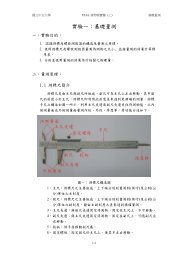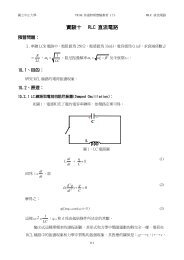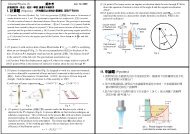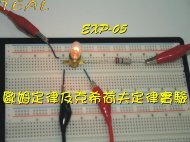Create successful ePaper yourself
Turn your PDF publications into a flip-book with our unique Google optimized e-Paper software.
Dec. 10, 2009<strong>Lecture</strong> 27
Outline (ch 17-18)• Temperature – the 0 th law of thermodynamics– Scale– Thermal expansion• Ideal gas– The state function for ideal gas– Boltzmann constant– Average velocity and the distribution of molecularspeed• Phase diagram– Vapor pressure and humidity– Partial pressure and relative humidity– Boil point– Dew point• Van der Waals gas
P. 455Chapter 17 Temperature, Thermal Expansion,and the Ideal Gas Law17-1 Atomic Theory of MatterOn a microscopic scale, the arrangementsof molecules in solids , liquids , and gasesAtomic mass unit : uThe atomic mass of 12 C = 12.0000 u1u= 1.6605×10−27KgThe atomic mass of hydrogen is 1.0078 u.The atoms of any substance are continuallyin motion.Heat-1 Heat-2CCU Physics 17 - 1
P. 459CCU Physics 17 - 217-3 The Zero Law of Thermodynamics and TemperatureZero Law of Thermodynamics :Two bodies in thermal equilibrium with a third arealso in thermal equilibrium with each other.They have the same temperature.A C B C A BThermometer
P. 458CCU Physics 17 - 3Temperature ScalesFahrenheit ( o F ) and Celsius ( o C )at P = 1atmFreezing point of water : 0 o C ( 32 o F )Boiling point of water : 100 o C ( 212 o F )o o oT( F) = 32 F + T( C)×o 9 o o20 C = ( 32 + 20 × ) F = 68 F595
Thermal expansionUse board
P. 460
P. 456
P. 45917-4 Thermal ExpansionC-Heat-1CCU Physics 17 - 419-08The atoms vibrate abouttheir equilibrium positionsA ∼ 10 -11 m , f ∼ 10 13 HzFor small ΔTΔ = α Δ0Tα : coefficient of linear expansionC-Heat-2
P. 461V+Δ V = ( +Δ )( w+Δ w)( h+Δh)= ( + α Δ T)( w+ αwΔ T)( h+ αhΔT)= wh + Δ T = V + Δ T + Δ T + ΔT3 2 2 3 3(1 α ) [1 3α 3 α α ]Δ V = 3αΔ TV = βΔTVβ = 3αCCU Physics 17 - 5coefficient ofvolume expansionLiquids generally increase in volumewith increasing temperature and haveaverage coefficients of volumeexpansion about ten times greater thanthose of solids. Water is an exception.ρ water(at40C)ismax
P. 46417-6 The Gas Laws and Absolute Temperature(1) For constant TemperaturePV = constant ( Boyle’s Law )(2) For constant PressureCCU Physics 17 - 6V∝ T ( Charles’s Law )Absolute Temperature T( K) = T( o C) + 273.15Unit : Kelvin (K)
P. 46517-7 Macroscopic Description of an Ideal Gas23Avogadro’s number N = 6.022 ×10ACCU Physics 17 - 719-12One mole of any substance is the amount of the substance thatcontains N A of constituent particles ( atoms or molecules).Number of mole of a substance is related to its mass m byM is the molar mass of the substance.n=mMEquation of State of an Ideal Gas : PV = nRTR = 8.314 J / mol⋅KNPV = nRT = RT = NkBTNA;kB= ×−231.38 10 /J K
P. 477Chapter 18 Kinetic Theory of Gases18-1 The Ideal Gas Law and TemperatureThe model of an ideal gas ( assumptions) :CCU Physics 18 - 1The gas consists of a very large number of identicalmolecules moving with random velocities.The molecules have no internal structure, so all theirkinetic energy is purely translational.The molecules do not interact except during brief elasticcollisions with each other and the walls of the container.The average distance between the molecules is muchgreater than their diameters.
P. 477CCU Physics 18 - 2Δ p = mv −( − mv ) = 2mvix ix ix ixThe time between twosuccessive collisionsFPiΔ pix= =Δ t∑ Fi= ==A2mN v xV12mvi∑=13Δ t =2ixmv2xiNm vV2 / vxim= ∑V1 1v = v = v = v = ∑ v3 N2 2 2 2 2x y z i xi2iv2xi21-02
P. 478CCU Physics 18 - 31 2 3m v = k T2 2 B132PV = Nm v = NkBT;vrms2 3kTB3RT= v = =m M1 2 1 2 1 2 1m vx = m vy = m vz = kBT2 2 2 2Each translation degree of freedom contributes 1 kT2 B1 3 32 2 22Ktot,trans= N m v = NkBT = nRTThe internal energy of an ideal gas depends only on the temperature.
18-2 Distribution of Molecular SpeedsThe molecules in a gas will not all have thesame speed; their distribution of speeds iscalled the Maxwell distribution:f( v)=2mv2 2kTAv e −withN = ∫ f ( v)dv0∞2A=4 πN( m/2 πkT) 3
18-2 Distribution of Molecular SpeedsThe Maxwell distribution depends only onthe absolute temperature. This figure showsdistributions for two different temperatures;at the higher temperature, the whole curveis shifted to the right.
18-3 Real Gases and Changes of PhaseThe curves here represent the behavior of thegas at different temperatures. The cooler itgets, the further the gas is from ideal.In curve D, the gasbecomes liquid; it beginscondensing at (b) and isentirely liquid at (a). Thepoint (c) is called thecritical point.Lower thetemperature
18-3 Real Gases and Changes of PhaseA PT diagram is called a phase diagram; itshows all three phases of matter. The solidliquidtransition is melting or freezing; theliquid-vapor one is boiling or condensing; andthe solid-vapor one is sublimation.Phase diagram ofwater.
Below the critical temperature, the gas canliquefy if the pressure is sufficient; above it, noamount of pressure will suffice.
Figure 18.5
P. 483Phase diagram of carbon dioxide
Example: Elevation effect onatmospheric pressure.a) Determine the variation in pressure in the Earth’satmosphere as a function of height y above sea level,assuming g is constant and that the density of the air isproportional to the pressure.b) At what elevation is the air pressure equal to half thepressure at sea level?c) What is the ‘boiling temperature’ of water at the top ofmountain Jade (about 4000m) if the pressure is 1 atm atsea level.
46×10360 K = 870 0C
P. 48418-4 Vapor Pressure and HumidityCCU Physics 18 - 7An open container of water can evaporate.The fastest molecules are escapingfrom the water’s surface, soevaporation is a cooling processThe inverse process is calledcondensation.When the evaporation andcondensation processes are inequilibrium, the vapor just abovethe liquid is said to be saturated,and its pressure is the saturatedvapor pressure.
The saturated vaporpressure increaseswith temperature.42×10333 K = 600 0C
P. 485CCU Physics 18 - 8Boiling and Dew PointThe saturated vapor pressureincreases with temperature.A liquid boils when its saturatedvapor pressure equals the externalpressure.The dew point is thetemperature at which thepartial pressure of waterequals the saturated vaporpressure. If the temperaturegoes below the dew point,dew, fog, or rain may occur.
P. 485CCU Physics 18 - 9Partial Pressure and Relative HumidityC-Heat-3Partial pressure is the pressure eachcomponent of a mixture of gases would exert ifit were the only gas present.The partial pressure of water in the air can beas low as zero, and as high as the saturatedvapor pressure at that temperature.Relative humidity is a measure of the saturationof the air.
18-5 Van der Waals Equation of StatePVv=V / n= nRTPv = RTvolume per moleFinite size of the molecules v→v−bRTP v b= −
Van der Waals Equation of StateIntermolecular forceReduced pressureΔP= −av2⎛⎜⎝RT aP = − v − b va ⎞P+ ( v b)RT2 ⎟ − =v ⎠2
P. 487CCU Physics 18 - 11The PV diagram for a Van der Waals gas fitsmost experimental data quite well.⎛⎜⎝a ⎞P+ ( v b)RT2 ⎟ − =v ⎠v=V / nvolume per moleNEXTaAt low densitiesP2v








